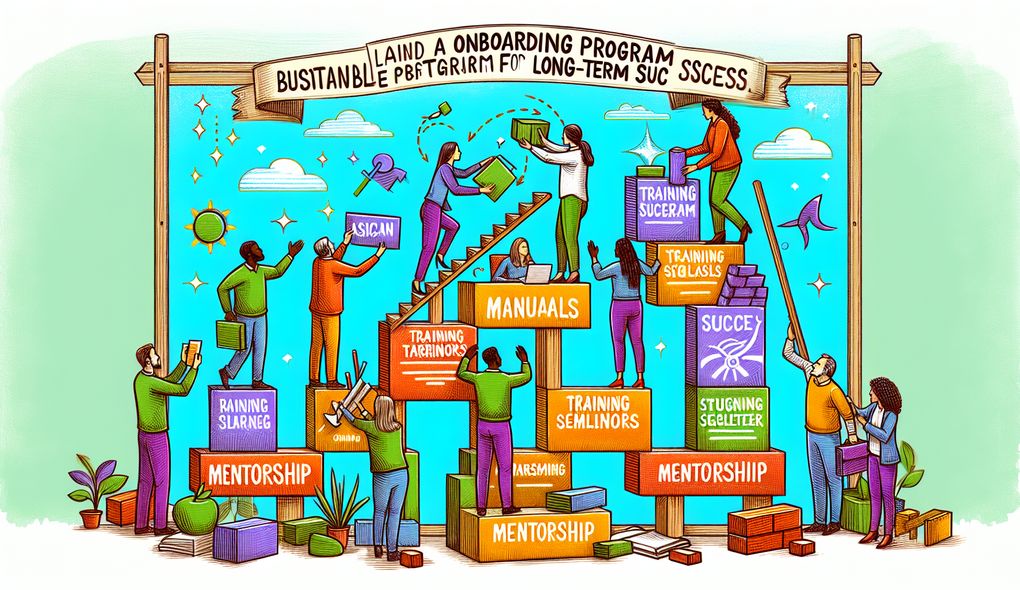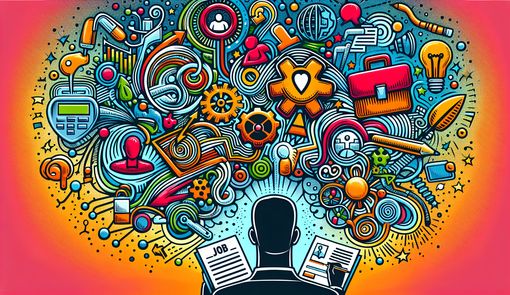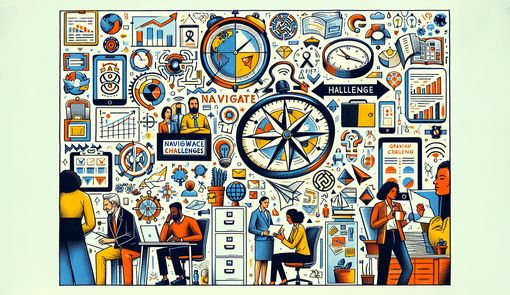Building a Sustainable Onboarding Program: Tips for Long-Term Success
Explore strategies to craft a sustainable onboarding program that drives long-term employee success and retention.

Onboarding new employees is a critical process for any organization. It sets the tone for an employee's experience and can significantly impact their performance, satisfaction, and retention. However, creating an onboarding program that remains effective over time, adapts to change, and consistently delivers value requires careful planning and execution. This article offers practical tips and guidance for building a sustainable onboarding program, designed to foster long-term success for both the employee and the company.
Understanding the Importance of a Sustainable Onboarding Program
A sustainable onboarding program is one that stands the test of time, is adaptable to organizational changes, and continuously incorporates feedback to improve. It's not just about making a good first impression; it's about laying a strong foundation for sustained employee engagement and growth. Effective onboarding can improve employee retention by up to 82% and productivity by over 70%, according to the Brandon Hall Group. Therefore, investing time and resources into a robust onboarding strategy pays off in the long run.
Tip 1: Establish Clear Objectives
Begin by setting explicit goals for what the onboarding program should achieve. These could include helping new hires understand the company culture, providing them with the necessary tools and information to perform their roles, and integrating them into their teams. Having clear objectives helps to create a structured and focused onboarding experience.
Tip 2: Foster a Culture of Welcoming and Inclusiveness
It's essential to create an environment where new hires feel welcomed and valued from day one. This involves not just HR but also the participation of managers and future colleagues. Plan welcome events, assign a buddy or mentor, and ensure regular check-ins to reinforce the feeling of community.
Tip 3: Implement a Phased Approach
Instead of overwhelming new employees with information on the first day, spread the learning process over several weeks or months. A phased approach to onboarding allows for gradual assimilation of information, which can be more effective for long-term retention.
Tip 4: Integrate Role-Specific Training and Expectations
Each role within your organization is unique, and onboarding should reflect that. Ensure that new hires understand what is expected of them and provide relevant training to meet those expectations. Tailored onboarding can significantly boost an employee’s confidence and performance.
Tip 5: Leverage Technology to Streamline the Process
Utilize digital tools to make onboarding more efficient and engaging. Online platforms can facilitate paperwork, training modules, and even virtual meet-and-greets. Technology can also help track progress and gather feedback throughout the onboarding process.
Tip 6: Continuous Improvement Through Feedback
Sustainable programs are never static. Regularly solicit feedback from new hires about their onboarding experience. Use this insight to continually refine your approach. Employee feedback is a valuable tool for understanding the effectiveness of onboarding and identifying areas for enhancement.
Tip 7: Measure the Success of the Onboarding Program
Define key performance indicators (KPIs) to evaluate the onboarding program's success objectively. These could include metrics like time to productivity, early-stage employee engagement, and the rate of retention. Tracking these metrics over time can provide tangible evidence of the program’s impact.
Tip 8: Encourage Cross-Departmental Collaboration
Onboarding shouldn't be the sole responsibility of the HR department. Encourage different departments to play a role in introducing new hires to the broader operations of the company. This cross-functional approach helps employees understand how their role contributes to the organization's success.
Tip 9: Personalize the Experience
While maintaining a consistent onboarding structure, it's also valuable to personalize the experience to the individual. Acknowledge the unique skills and backgrounds that new hires bring to the team, and show how they can contribute to the company's objectives.
Tip 10: Prioritize Employee Well-being
An employee who feels cared for is more likely to feel engaged and committed to the company. Ensure that the onboarding program addresses aspects of work-life balance, mental health, and overall well-being.
Conclusion
Building a sustainable onboarding program is an evolving process that reflects an organization's commitment to its employees' success. By implementing these tips, companies can create an onboarding experience that not only welcomes new hires but also promotes their long-term growth and retention. Each element of the onboarding process—from cultural integration to personalized training—plays a crucial role in forging a productive and harmonious workplace where employees thrive and organizations flourish.
Frequently Asked Questions
1. Why is onboarding important for an organization?
Onboarding is crucial for organizations as it sets the foundation for new employees' success. It helps in integrating new hires into the company culture, familiarizing them with their roles, and ensuring a smooth transition, which ultimately leads to higher retention rates and productivity.
2. How can companies ensure the long-term sustainability of their onboarding program?
Companies can ensure the long-term sustainability of their onboarding program by establishing clear objectives, fostering a culture of inclusiveness, implementing a phased approach, providing role-specific training, leveraging technology, seeking continuous feedback for improvement, measuring program success through KPIs, encouraging cross-departmental collaboration, personalizing the experience, and prioritizing employee well-being.
3. What are the key benefits of a sustainable onboarding program?
A sustainable onboarding program offers numerous benefits such as increased employee retention, higher productivity levels, improved employee engagement, better cultural assimilation, enhanced job satisfaction, and a positive impact on organizational performance and success.
4. How can technology enhance the onboarding process?
Technology can streamline the onboarding process by facilitating paperwork, offering online training modules, enabling virtual interactions, and tracking progress. It makes the onboarding experience more efficient, engaging, and allows for seamless communication between new hires and the organization.
5. How can companies assess the effectiveness of their onboarding program?
Companies can assess the effectiveness of their onboarding program by defining measurable KPIs such as time to productivity, employee engagement levels, retention rates, and feedback from new hires. Analyzing these metrics helps in understanding the program's impact and areas that may need improvement.
Further Resources
For further insights and guidance on building a sustainable onboarding program for long-term success, the following external resources can provide valuable information:
- SHRM Onboarding Resources: The Society for Human Resource Management offers a comprehensive collection of articles, guides, and best practices for creating effective onboarding programs.
- LinkedIn Learning: Onboarding New Hires: Access online courses and tutorials on onboarding strategies, techniques, and tools to enhance your onboarding process.
- Harvard Business Review - The Elements of Onboarding: Listen to a podcast episode from Harvard Business Review discussing crucial elements of successful onboarding and how it impacts employee retention.
- TalentLMS Onboarding Software: Explore onboarding software solutions from TalentLMS to streamline and digitize your onboarding process for improved efficiency and effectiveness.
- Gallup - Employee Onboarding: Strategies for Success: Read an in-depth article by Gallup that dives into the strategies and practices for successful employee onboarding that drives engagement and performance.
- Onboarding Checklist Template: Download a customizable onboarding checklist template from Smartsheet to help you stay organized and ensure all important steps are covered during the onboarding process.
- Innovative Onboarding Ideas: Discover creative and innovative onboarding ideas to make the onboarding experience memorable and engaging for new hires.
- Ultimate Guide to Employee Onboarding: Access Workable's ultimate guide to employee onboarding with practical tips, templates, and resources to build a successful onboarding program.
- Deloitte: Reinventing Onboarding for Virtual Work: Learn from Deloitte's insights on reinventing onboarding strategies for transitioning new hires into virtual work environments.
- Remote Onboarding Best Practices: Explore best practices for remote onboarding to effectively welcome and integrate new employees joining your organization remotely.

 Resume and Cover Letter Writing
Resume and Cover Letter Writing Interview Preparation
Interview Preparation Career Development
Career Development Networking and Personal Branding
Networking and Personal Branding Workplace Skills
Workplace Skills Job Search Strategies
Job Search Strategies Work-Life Balance
Work-Life Balance Salary Negotiation
Salary Negotiation Career Transitions
Career Transitions Navigating Workplace Challenges
Navigating Workplace Challenges Professional Growth
Professional Growth Trends in the Workplace
Trends in the Workplace